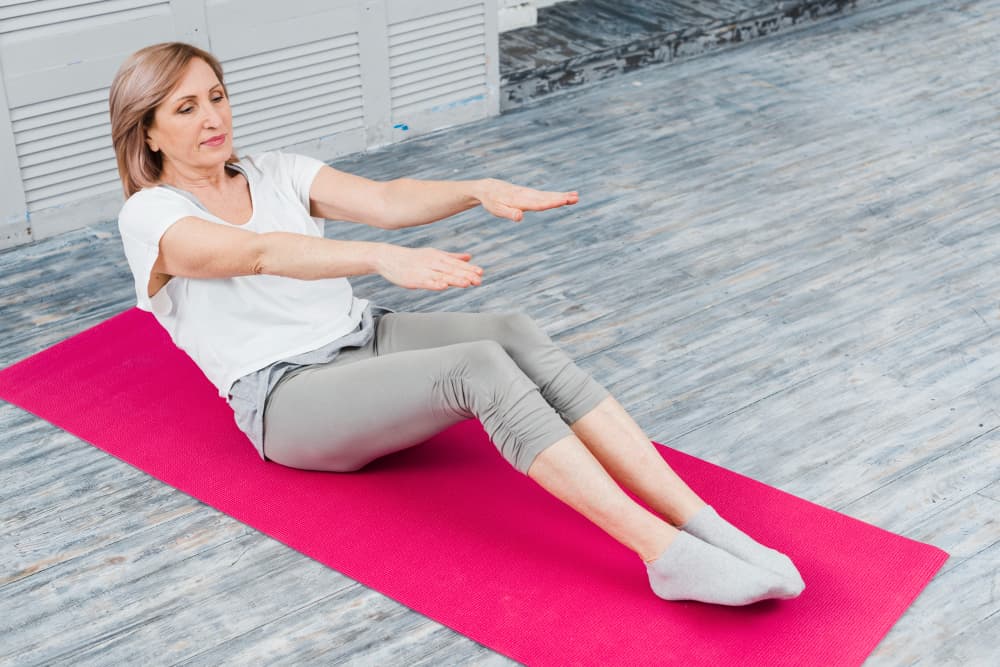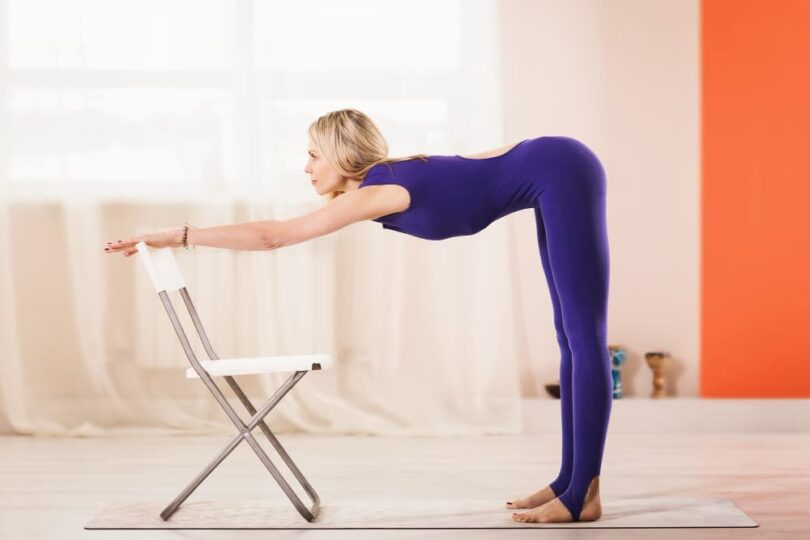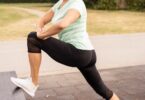Chair yoga is an excellent way for seniors to stay active and maintain their health. It offers numerous benefits, including improved flexibility, strength, and mental well-being. This article explores whether chair yoga is good for seniors by examining its benefits, providing instructions on getting started, and sharing safety tips. We’ll also delve into frequently asked questions to give a thorough understanding of chair yoga for older adults.
Introduction to Chair Yoga
Overview of Chair Yoga
Chair yoga, a form of yoga that adapts traditional yoga poses to be performed while seated in a chair or using a chair for support, is particularly beneficial for seniors. It allows older adults to reap the benefits of yoga without the need for getting down on the floor. This adaptation makes yoga accessible to those with limited mobility, balance issues, or other physical limitations.
Importance of Yoga for Seniors
As we age, staying active becomes crucial for maintaining health and independence. Traditional forms of exercise might be too strenuous or unsafe for some seniors, making chair yoga an excellent alternative. This gentle form of exercise helps in maintaining physical health, mental clarity, and emotional balance. But, you might wonder, is chair yoga really good for seniors? Let’s find out.
Health Benefits of Chair Yoga
Physical Benefits
Chair yoga provides numerous physical benefits, making it a valuable exercise for seniors. Firstly, it improves flexibility. Many seniors face stiffness in their muscles and joints, which can hinder daily activities. Chair yoga helps stretch these muscles and joints gently, enhancing mobility.
Additionally, chair yoga builds strength. Using the chair for support allows seniors to perform strength-building exercises without the risk of falling. This is crucial for maintaining muscle mass and overall body strength, which often diminishes with age.
Lastly, balance is another key benefit. Poor balance can lead to falls and injuries, a common concern for older adults. Through specific poses and exercises, chair yoga strengthens the core muscles, improving balance and stability.
Mental and Emotional Benefits
Chair yoga isn’t just about physical health; it’s also beneficial for mental and emotional well-being. Practicing yoga can significantly reduce stress and anxiety. The mindful breathing techniques and relaxation exercises involved help calm the mind and reduce the levels of cortisol, the stress hormone.
Moreover, chair yoga can boost mood. The gentle physical activity stimulates the release of endorphins, often called the “feel-good” hormones, which enhance overall mood and create a sense of happiness and well-being.
Social Benefits
One often overlooked benefit of chair yoga is its social aspect. Participating in chair yoga classes can provide seniors with a sense of community. Social interactions are vital for emotional health, and group classes offer a supportive environment where seniors can connect with others, reducing feelings of isolation.
Chair yoga for seniors is more than just an exercise routine; it’s a holistic approach to improving health and well-being. Next, we’ll discuss how to get started with chair yoga, from choosing the right chair to basic poses.
Related Article: What is Chair Yoga for Seniors: Benefits and Poses Explained
Getting Started with Chair Yoga
Choosing the Right Chair
Before you begin practicing chair yoga, it’s essential to select the right chair. The ideal chair is sturdy, without wheels, and has a straight back. Avoid chairs that are too soft or cushy, as they don’t provide the necessary support. A dining room or folding chair works well. Make sure the chair is placed on a flat surface to prevent any slipping during your yoga session.
Necessary Equipment
While chair yoga is quite accessible and doesn’t require much equipment, having a few items can make your practice more comfortable and effective. A yoga mat placed under the chair can prevent slipping and provide extra cushioning for your feet. Wearing comfortable clothing that allows for free movement is also important. You might also want to have a water bottle nearby to stay hydrated.
Basic Chair Yoga Poses
Starting with simple poses can help you get comfortable with chair yoga. Here are a few basic poses to begin your practice:
Seated Mountain Pose
The seated mountain pose is a great starting point. Sit up straight with your feet flat on the ground and knees at a 90-degree angle. Place your hands on your thighs, palms facing down. Engage your core and take deep breaths, feeling your spine lengthen with each inhale. This pose helps improve posture and prepares you for more dynamic poses.
Seated Cat-Cow Stretch
This stretch is excellent for flexibility and mobility in the spine. Sit with your hands on your knees. As you inhale, arch your back and look up (cow pose). As you exhale, round your back and tuck your chin to your chest (cat pose). Repeat this sequence several times, moving with your breath. This pose helps relieve tension in the back and improves spinal flexibility.
Seated Forward Bend
The seated forward bend is a gentle stretch for the back and hamstrings. Sit up straight and, on an exhale, hinge forward from your hips, reaching your hands towards your feet. Keep your back straight and only go as far as comfortable. Hold for a few breaths, and then slowly sit back up. This pose helps stretch the lower back and legs.

Chair Yoga Routines
Simple Chair Yoga Routine for Beginners
Starting with a simple routine can help you get used to chair yoga and its benefits. Here’s a step-by-step guide to a beginner-friendly chair yoga sequence:
- Seated Mountain Pose (Tadasana)
- Sit up straight with your feet flat on the ground.
- Place your hands on your thighs, palms down.
- Take deep breaths, lengthening your spine with each inhale.
- Seated Cat-Cow Stretch
- Place your hands on your knees.
- Inhale, arch your back, and look up (Cow Pose).
- Exhale, round your back, and tuck your chin to your chest (Cat Pose).
- Repeat for five breaths.
- Seated Forward Bend
- Sit up straight and exhale as you hinge forward from your hips.
- Reach your hands towards your feet, keeping your back straight.
- Hold for a few breaths, then slowly sit back up.
- Seated Side Stretch
- Raise your right arm overhead and lean to the left.
- Hold for a few breaths, feeling the stretch along your right side.
- Switch sides and repeat.
- Seated Spinal Twist
- Sit up straight and place your right hand on the back of the chair.
- Place your left hand on your right knee.
- Twist to the right, looking over your shoulder.
- Hold for a few breaths, and then switch sides.
- Seated Pigeon Pose
- Place your right ankle on your left knee.
- Sit up straight and gently press down on your right knee.
- Hold for a few breaths, and then switch sides.
Modifications and Variations
Chair yoga can be adapted to fit your needs. If a pose feels too challenging, try modifying it. For example, if the seated forward bend is too intense, you can place your hands on your shins instead of reaching for your feet. Using a strap or towel to assist with poses can also make them more accessible.
Advanced Chair Yoga Routines
Once you’re comfortable with the basics, you can move on to more advanced routines. These include more dynamic movements and deeper stretches:
- Seated Warrior I
- Sit sideways on the chair, with one leg extended back.
- Raise your arms overhead and hold for a few breaths.
- Switch sides and repeat.
- Seated Warrior II
- Sit sideways on the chair, extend your front leg forward and back leg behind you.
- Extend your arms out to the sides and hold for a few breaths.
- Switch sides and repeat.
- Seated Tree Pose
- Place your right foot on your left ankle, shin, or thigh (avoid the knee).
- Bring your palms together in front of your chest.
- Hold for a few breaths, then switch sides.
- Seated Sun Salutation
- Combine poses like Seated Mountain, Forward Bend, Cat-Cow, and Side Stretch in a flowing sequence.
- Move with your breath and repeat several times.
Combining Chair Yoga with Other Exercises
Chair yoga can be combined with other exercises like gentle strength training or aerobic activities. For example, you can do some light hand-weight exercises or leg lifts while seated. Adding variety keeps your routine interesting and can help improve overall fitness.
Chair yoga routines offer a versatile way to stay active and improve flexibility, strength, and balance. Whether you’re a beginner or looking for more advanced sequences, there’s a routine that can fit your needs. In the next part, we’ll cover important safety tips and precautions to keep in mind while practicing chair yoga.
Related Article: Easy 7-Minute Chair Yoga for Seniors: Simple Exercises
Safety Tips and Precautions
Common Precautions
While chair yoga is generally safe for seniors, it’s important to take some precautions to avoid injury. Firstly, always listen to your body. If a pose feels uncomfortable or painful, stop immediately. It’s normal to feel a gentle stretch, but you should never experience sharp pain. Start slowly, especially if you’re new to yoga or haven’t been active for a while.
When to Avoid Certain Poses
Certain conditions may require you to avoid specific poses. For instance, if you have severe osteoporosis, avoid poses that involve forward bends or twisting, as these can put too much pressure on the spine. Similarly, if you have high blood pressure, avoid poses that have you lifting your arms overhead for extended periods. It’s essential to know your limits and adjust accordingly.
Importance of Consulting a Doctor
Before starting any new exercise routine, including chair yoga, it’s a good idea to consult with your doctor. This is especially true if you have any chronic health conditions or concerns about your ability to perform the exercises. Your doctor can provide personalized advice and let you know if there are any specific poses you should avoid.
Stay Hydrated and Take Breaks
Staying hydrated is crucial, especially when exercising. Keep a water bottle nearby and take sips as needed. Additionally, don’t be afraid to take breaks. If you start to feel tired or dizzy, sit quietly and breathe deeply until you feel ready to continue.
Use Support When Needed
Using support can make a big difference in your practice. For instance, placing a pillow or cushion on the chair can provide extra comfort and support. If you feel unsteady, make sure the chair is against a wall or have someone nearby to help if needed. Using a yoga strap can also help with flexibility, allowing you to perform poses without straining.
Pay Attention to Your Breathing
Breathing is an essential part of yoga. Always breathe deeply and evenly throughout your practice. If you find yourself holding your breath, it’s a sign to ease up on the pose. Proper breathing can help you stay calm and focused, enhancing the benefits of the exercise.
Focus on Proper Form
Maintaining proper form is more important than how far you can stretch or bend. Pay attention to your posture and make sure you’re performing the poses correctly. Poor form can lead to injuries and diminish the effectiveness of your practice.
Testimonials and Case Studies
Real-life Experiences with Chair Yoga
Chair yoga has made a significant impact on many seniors’ lives, helping them stay active and healthy. Let’s look at some testimonials from those who have experienced its benefits firsthand.
Jane, a 72-year-old retiree, shared her story: “I was hesitant to start yoga because I thought it was too intense for me. But chair yoga was a game-changer. It’s gentle yet effective. I feel more flexible, and my back pain has reduced significantly. Plus, I’ve met some wonderful people in my class!”
Similarly, Tom, 68, found chair yoga beneficial for his balance issues. “I had a few falls last year, which really knocked my confidence. Chair yoga has helped me regain my balance and strength. I’m more confident moving around now and haven’t had a fall since I started.”
Case Studies
Case Study 1: Improved Mobility
Mary, an 80-year-old with arthritis, struggled with mobility. After six months of practicing chair yoga twice a week, she noticed remarkable improvements. Her range of motion increased, and daily activities became easier. Mary could now climb stairs and participate in social activities she previously avoided due to pain and stiffness.
Case Study 2: Enhanced Mental Well-being
Bob, a 75-year-old widower, faced significant anxiety and depression after losing his spouse. He joined a chair yoga class at his local community center to try something new. Over time, Bob found that the gentle exercise and social interaction lifted his spirits. “Chair yoga has given me a sense of peace. The breathing exercises help calm my mind, and being around others has helped me feel less lonely.”
Case Study 3: Strength and Endurance
Linda, 67, was looking for a way to stay active without aggravating her joint issues. Chair yoga provided a perfect solution. After participating in a 12-week chair yoga program, Linda reported increased strength and endurance. She could carry groceries and play with her grandchildren without feeling exhausted. “I love how chair yoga has made me stronger without putting too much strain on my joints,” she said.
Case Study 4: Balance and Coordination
Harry, 70, struggled with coordination due to Parkinson’s disease. His physical therapist recommended chair yoga to help with his symptoms. After three months of regular practice, Harry saw noticeable improvements in his balance and coordination. He felt more stable on his feet and had fewer tremors. “Chair yoga has been a fantastic addition to my treatment plan. It’s helped me manage my symptoms better,” Harry shared.
FAQs
How often should seniors do chair yoga?
Seniors can benefit from doing chair yoga regularly, ideally three to five times a week. This frequency helps maintain flexibility, strength, and overall well-being. However, it’s essential to listen to your body and not overdo it. Starting with shorter sessions and gradually increasing the duration as you become more comfortable can be a good approach.
Can you lose weight doing chair yoga for seniors?
While chair yoga primarily focuses on flexibility, balance, and relaxation, it can contribute to weight loss when combined with a healthy diet and other physical activities. The gentle movements help burn calories, though not as intensively as more vigorous exercises. Regular practice can improve overall fitness, making it easier to stay active and manage weight.
What type of yoga is best for seniors?
Chair yoga is particularly well-suited for seniors due to its gentle approach and adaptability. Other types of yoga that might be beneficial include Hatha yoga, which emphasizes slow and gentle movements, and restorative yoga, which focuses on relaxation and stress relief. Always choose a style that matches your fitness level and health needs.
How effective is chair yoga?
Chair yoga is highly effective for improving flexibility, strength, balance, and mental well-being in seniors. It provides a safe and accessible way to enjoy the benefits of yoga without the risk of falls or strain. Many seniors find that regular practice leads to better mobility, reduced pain, and an overall sense of well-being.
Conclusion
Chair yoga stands out as an excellent choice for seniors looking to stay active and maintain their health. It offers numerous benefits, including improved flexibility, strength, and mental well-being, all while being accessible and gentle on the body.
By incorporating chair yoga into your routine, you can experience greater mobility, reduced pain, and a boost in overall happiness. Whether you’re a beginner or have some yoga experience, chair yoga provides a safe and effective way to enjoy the benefits of this ancient practice.
So, why not give chair yoga a try? With the tips, routines, and safety precautions we’ve discussed, you’re well on your way to starting a fulfilling chair yoga practice. Embrace this gentle form of exercise and enjoy the many advantages it brings to your physical and mental health.







